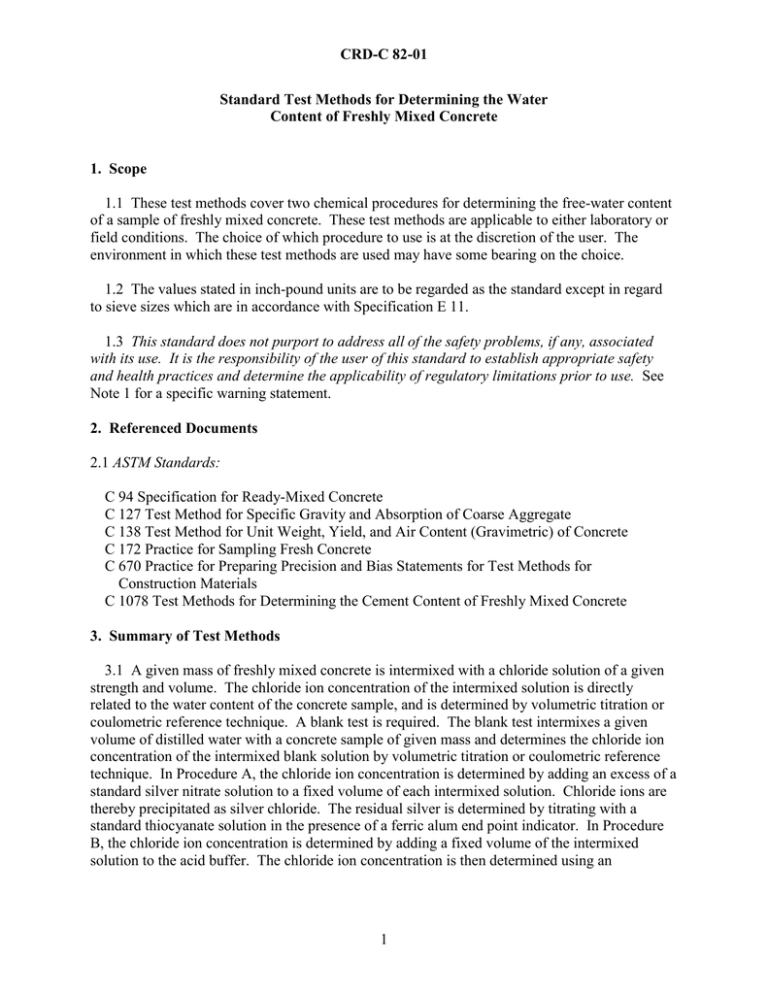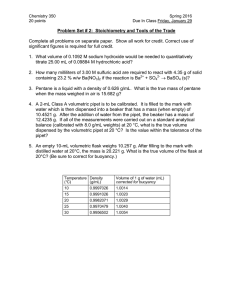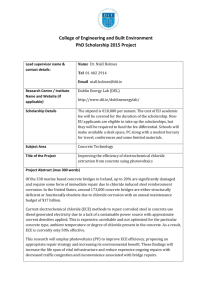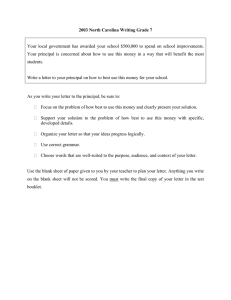CRD-C 82-01 Standard Test Methods for Determining the Water 1. Scope
advertisement

CRD-C 82-01 Standard Test Methods for Determining the Water Content of Freshly Mixed Concrete 1. Scope 1.1 These test methods cover two chemical procedures for determining the free-water content of a sample of freshly mixed concrete. These test methods are applicable to either laboratory or field conditions. The choice of which procedure to use is at the discretion of the user. The environment in which these test methods are used may have some bearing on the choice. 1.2 The values stated in inch-pound units are to be regarded as the standard except in regard to sieve sizes which are in accordance with Specification E 11. 1.3 This standard does not purport to address all of the safety problems, if any, associated with its use. It is the responsibility of the user of this standard to establish appropriate safety and health practices and determine the applicability of regulatory limitations prior to use. See Note 1 for a specific warning statement. 2. Referenced Documents 2.1 ASTM Standards: C 94 Specification for Ready-Mixed Concrete C 127 Test Method for Specific Gravity and Absorption of Coarse Aggregate C 138 Test Method for Unit Weight, Yield, and Air Content (Gravimetric) of Concrete C 172 Practice for Sampling Fresh Concrete C 670 Practice for Preparing Precision and Bias Statements for Test Methods for Construction Materials C 1078 Test Methods for Determining the Cement Content of Freshly Mixed Concrete 3. Summary of Test Methods 3.1 A given mass of freshly mixed concrete is intermixed with a chloride solution of a given strength and volume. The chloride ion concentration of the intermixed solution is directly related to the water content of the concrete sample, and is determined by volumetric titration or coulometric reference technique. A blank test is required. The blank test intermixes a given volume of distilled water with a concrete sample of given mass and determines the chloride ion concentration of the intermixed blank solution by volumetric titration or coulometric reference technique. In Procedure A, the chloride ion concentration is determined by adding an excess of a standard silver nitrate solution to a fixed volume of each intermixed solution. Chloride ions are thereby precipitated as silver chloride. The residual silver is determined by titrating with a standard thiocyanate solution in the presence of a ferric alum end point indicator. In Procedure B, the chloride ion concentration is determined by adding a fixed volume of the intermixed solution to the acid buffer. The chloride ion concentration is then determined using an 1 CRD-C 82-01 instrumental coulometric reference technique. (If the blank test indicates no chlorides are present in the concrete, the blank test may be waived in subsequent testing.) 4. Significance and Use 4.1 The test results can be used to determine variability of water content in a batch of concrete and the variability of water content between different batches of nominally identical concrete. If these test methods are used to indicate concrete uniformity, correct and appropriate sampling procedures must be followed. Sampling procedures are referenced in Section 6 of these test methods. 4.2 The water-cement ratio of a concrete sample can be estimated if these test methods are used in conjunction with Test Methods C 1078. 5. Purity of Reagents 5.1 Purity of Reagents−Reagent grade chemicals shall be used in all tests. Unless otherwise indicated, it is intended that all reagents shall conform to the specifications of the Committee on Analytical Reagents of the American Chemical Society, where such specifications are available. Other grades may be used, provided it is first ascertained that the reagent is of sufficiently high purity to permit its use without lessening the accuracy of the determination. A comparison of results obtained using the proposed grades with results obtained using reagent grade chemicals shall be made to ensure that the proposed grades are sufficiently pure, unless previous records confirm they are satisfactory. 5.2 Purity of Water−Unless otherwise indicated, all references to water shall be understood to mean distilled water or water of equal purity. 6. Sampling 6.1 The sample of concrete from which the water-content test specimens are made shall be representative of the entire batch and have a mass of not less than 20 kg. It shall be obtained in accordance with Specification C 94 or Practice C 172. Specification C 94 outlines procedures for sampling for uniformity of concrete produced in truck mixers. If wet sieving of aggregates larger than 1-1/2 inch is not permitted, the wide-mouth jar in 7.1.4 should be large enough to accommodate larger aggregate concrete. PROCEDURE A− −BY VOLUMETRIC TITRATION METHOD 7. Apparatus 7.1 The following comprise a recommended minimum selection of apparatus for use in conducting the required analysis. Apparatus other than that described in this section can be used, provided they serve the same function. An acceptable selection of apparatus is shown in Fig.1. 2 CRD-C 82-01 Fig.1. Equipment Required for Determining the Water Content of Freshly Mixed Concrete Using Procedure A 7.1.1 Balance, having a minimum capacity of 2600 g and sensitivity of at least 0.1 g. 7.1.2 Shovel, Hand Scoops, and Rubber Gloves as required. 7.1.3 Sample Tub, 5-qt (4.7-L) polyethylene. 7.1.4 Wide-Mouth Jar, 1/2-gal (1.9-L) polyethylene, with screw closure and lid. 7.1.5 Universal Mixer−An end-over-end mixer, driven at 40 to 60 r/min capable of holding and turning end-over-end a 1/2-gal ( 1.9-L) wide-mouth jar containing 2.5 kg of material. It shall be equipped with a 0 to 15 min timer and switch. 7.1.6 Conical Beaker or Erlenmeyer Flask−A 500-mL narrow-mouth conical beaker or Erlenmeyer flask. 7.1.7 Pipet, 25-mL volumetric glass, class A or B. 7.1.8 Automatic Pipets, 25 and 10 mL glass with poly-tetrafluoroethylene (PTFE) plug. Two 25-mL automatic pipets are required. Alternatively, any volumetric dispenser that has an accuracy equal to or greater than ±0.05 mL and a reproducibility equal to or greater than ±0.02 mL may be used. 3 CRD-C 82-01 7.1.9 Amber Reagent Bottles, two narrow-mouth, Boston, round, amber, polypropylene, 32-oz. or 0.95 to 1-L reagent bottles. They shall be equipped with two No. 6 rubber stoppers, one with two holes, and one with three. They shall also be equipped with glass tubing, siphon lines, 7-mm outside diameter (standard wall required); two for the three hole stopper and one for the two hole stopper. There shall be 10 ft (3.0 m) of 1/4-in. (6.4-mm) inside diameter amber rubber-latex tubing required to connect the glass siphon lines to the 25-mL automatic pipets. 7.1.10 Buret, 100-mL acrylic body, Class A or B accuracy with a PTFE plug. 7.1.11 Volumetric Flask, two 500-mL polyethylene volumetric flasks. 7.1.12 Fixed-Volume Dispensers, polyethylene with polypropylene measuring chambers. One 2-mL and two 5-mL dispensers are required. 7.1.13 Carboys, rectangular, aspirator-type 2-ga1 (7.6-L) linear polyethylene carboys. 7.1.14 Clamps−One double-buret holder and one utility clamp, having a three-pronged grip and vinylized jaws. 8. Reagents 8.1 Nitric Acid Solution (1 + 1)−Carefully add one volume of concentrated nitric acid (HNO3, sp gr 1.42) to one volume of water. 8.2 Ferric Alum Indicator Solution−Dissolve 50 g of ferric ammonium sulphate [FeNH4(SO4)2 • 12H2O] in 100 mL of water and add 5 drops of nitric acid solution (1 + 1). 8.3 Nitrobenzene (C6HsNO2) (sp gr 1.20) NOTE l: Warning−Nitrobenzene is extremely toxic and is rapidly absorbed through the skin. Contact with the skin or clothing and inhalation of fumes and vapors shall be avoided. Due precaution shall be observed when using the material. 8.4 Potassium Thiocyanate Solution (0.05N)−Dissolve 24.3 ± 0.2 g of dry potassium thiocyanate (KSCN) in water and dilute to 5 L. 8.5 Silver Nitrate Solution (0.5N)−Dissolve 255 ± 2 g of dry silver nitrate (AgNO3) in water and dilute to 3 L. 8.6 Sodium Chloride Solution (0.5N)−Dissolve 292 ± 3 g of dry sodium chloride (NaCl) in tap water and dilute to 10 L. NOTE 2−Dry NaCl crystals dissolve slowly, and mechanical agitation is recommended to ensure that the crystals completely dissolve. 4 CRD-C 82-01 9. Calibration 9.1 Blank Equivalent Constant−Using an automatic pipet, place 10 mL of 0.5N AgNO3 solution into a beaker. Using fixed-volume dispenser, add 10 mL of 1 + 1 HNO3, 5 mL of ferric alum indicator solution, and 2 mL of nitrobenzene to the beaker. Swirl the contents of the beaker well for a few seconds. Titrate the solution using a 100-mL buret of 0.05N KSCN solution. Swirl the contents of the beaker during titration. Stop the titration when the first permanent reddish-brown color appears. Record the volume of KSCN required to reach the end point. This volume is the blank equivalent constant. 9.2 Water Content versus Potassium Thiocyanate End Point−Weigh out 100.0 ± 0.1 g (100 mL) of water. Place the water in a clean, wide-mouth jar. Using a volumetric flask, add 500 mL of 0.5N NaCl solution. Secure the lid and mix in a universal mixer for 3 min. Remove the jar from the mixer. Withdraw a 25-mL sample of the intermixed solution using a volumetric pipet. Place the 25-mL sample in a conical beaker. Using an automatic pipet, add 25 mL of 0.5N AgNO3 to the beaker and, using fixed-yolume dispensers, add 10 mL of 1 + 1 HNO3, 5 mL of ferric alum indicator solution, and 2 mL of nitrobenzene. Swirl well. Titrate using the 100-mL buret of 0.05N KSCN solution. Swirl the contents of the beaker during titration. Titrate to a permanent reddish-brown color end point. Record the volume of KSCN. This is the KSCN volume required for a chloride-free concrete specimen containing 100 g of water. 9.3 Water Content versus Total Potassium Thiocyanale Calibration Curve−Repeat the procedure in 9.2 for 140.0 ± 0.1 g and 180.0 ± 0.1 g of water. Plot the water content in grams versus KSCN in millilitres. Draw a smooth curve through the calibration data. 9.4 Calibration Requirements −The calibration procedures in 9.1 through 9.3 are required each time new reagents are used. A single-point calibration check in accordance with 9.2 is required on a weekly basis before testing concrete specimens. If the single-point calibration check differs from the established value by more than ±0.50 mL of KSCN, a complete recalibration is required. 10. Procedure 10.1 To obtain the test specimen, weigh out two test specimens of 2000 ± 200 g each from the sample obtained in accordance with 6.1. Record the exact mass of each test specimen to the nearest gram. Correct for coarse aggregate variance by using the procedure in Section 19 when nominal aggregate size exceeds 1-1/2 in. NOTE 3−A wide range of sample mass is allowed to prevent the mol1ar-aggregate ratio from being biased through the adjustment of the sample size. 10.2 Place each specimen into individual wide-mouth jars. Using a volumetric flask, add 500 mL of 0.5N NaCl solution to one (sample) and 500 mL of water to the other (blank). Secure the lids on the jars. 5 CRD-C 82-01 10.3 Turn the two jars end-over-end, either by hand or in an end-over-end mixer. At least 75 complete revolutions are recommended if the jars are turned by hand; if turned by a 40- to 60-r/min mixer, at least 2 min are recommended. Under no circumstances shall the jars be turned at a speed exceeding 80 r/min; excessive speeds prevent the salt solution and distilled water from completely mixing with the concrete samples. 10.4 Remove the jars from the mixer. Loosen the lids and allow the contents to settle for 3 to 5 min. Using volumetric pipets, withdraw 25 mL each of the clear sample and the blank solutions, and place into separate conical beakers. Using an automatic pipet, add 25 mL of 0.5N AgNO3 solution to the sample and 10 mL of 0.5N AgNO3 solution to the blank. Using fixedvolume dispensers, add 10 mL of 1 + 1 HNO3, 5 mL of ferric alum indicator solution, and 2 mL of nitrobenzene to each beaker. Swirl well. 10.5 The chloride strength of the sample and blank solutions in the beakers are determined by titration using the 0.05N KSCN solution (in a 100-mL buret). The titration is speeded by initially adding 25 mL of 0.05N 0.05N KSCN with an automatic pipet and then completing the titration with KSCN from the 100-mL buret. Swirl the contents of the sample and blank beakers during titration. Stop the titrations when the first permanent reddish-brown color appears. Record the volumes of KSCN solution required to reach the sample and the blank end points. If the concrete being tested does not contain chlorides, use of the blank may be discontinued after the initial determination. 11. Calculation 11.1 Calculate the KSCN equivalent, y, of the blanks in mL as follows: y=a−x where: a x = the blank equivalent constant in accordance with 9.1, mL, and . = the volume of KSCN required to reach the end point of the blank in accordance with 10.5, mL. 11.2 The water content is determined by using the calibration curve described in 9.3. The KSCN value used with the calibration curve is the sum of the volume of the potassium thiocyanate solution required for the sample (as determined in 10.5) and the potassium thiocyanate equivalent of the blank (y). The computed water content is in grams. (KSCN value to use with curve) 11.2.1 The computed water content is often stated as a percent of the total specimen weight by dividing the computed water content, w, by the recorded mass of the test sample, w, and multiplying by 100. % Water = ( w / ms ) × 100 11.2.2 The computed water content can be expressed as Ib/yd3. 6 CRD-C 82-01 Water, lb/yd3 = ( w / ms ) 27W where: w = computed water content of the test sample, g, m = mass of the test sample, g, and W = unit weight of the concrete in accordance with Test Method C 138, lb/ft3. 12. Precision and Bias 12.1 Precision−The single-operator standard deviation has been found to be 0.55 % water A, percent by weight of the total water (approximately 1.9 lb water/yd3 based on a content of 340 lb water/yd3). Based on this single-operator standard deviation, results of two properly conducted tests by the same operator on the same material shall not differ by more than 1.56 % (approximately 5.3 lb water/yd3)1. Multilaboratory data has not been obtained. 12.2 Bias-Bias has not been determined for this test method. NOTE 4−The precision values stated here are based on “research type” laboratory conditions. Field testing performed thus far supports these values without increase in error. PROCEDURE B− −COUWMETRIC REFERENCE TECHNIQUE 13. Apparatus 3.1 The following comprise a recommended minimum selection of apparatus for use in conducting the required analysis. Apparatus other than that described in this section can be used, provided they serve the same function. An acceptable selection of apparatus is shown in Fig.2. 13.1.1 Balance, having a minimum capacity of 2600 g and sensitivity of at least 0.1 g. 13.1.2 Hand Scoop, Square-mouth, cast aluminum, bowl size, approximately 3 in. wide by 8 in. long (80 mm by 200 mm). 13.1.3 Sample Tub, 5-qt (4.7-L) polyethylene. 13.1.4 Wide-Mouth Jar, 1/2-gal (1.9 L) polyethylene with screw closure and lid. 13.1.5 Centrifuge, variable-speed, 4-place centrifuge for 15-mL tubes. 13.1.6 Centrifuge Tubes, 15-mL, disposable polystyrene centrifuge tubes (2/test). 1 These numbers represent, respectively, the (1s) and (d2s) limits as described in Practice C 670. 7 CRD-C 82-01 Fig. 2. Equipment Required to Determining the Water Content of Freshly Mixed Concrete Using Procedure B 13.1.7 Automatic Pipet, 100-µL tip-ejector fixed-volume, pipet. 13.1.8 Disposable Pipet Tips, Disposable tips for the 100-µL pipets. 13.1.9 Chloride Meter −A chloride meter capable of accepting either 20-µL or l00-µL samples and making the coulometric determination of chloride with the precision of the duplicate chloride determinations having a coefficient of variation of 1.0 %. 13.1.10 Volumetric Flask, 250-mL, polypropylene volumetric flask. 13.1.11 Carboy, 2-gal (7.6-L), linear polyethylene, rectangular carboy with a spigot and a screw closure. 14. Reagents 14.2 Sodium Chloride Solution (0.5N)−Dissolve 292 ± 3 g of dry NaCl in tap water, and dilute to 10 L. NOTE 5−Dry NaCl crystals dissolve slowly, and mechanical agitation is recommended to ensure that the crystals completely dissolve. 14.3 Acid Buffer Solution−A prepared reagent consisting of 0.9 g/100 mL of polyvinyl alcohol, 4.8 g/100 mL glacial acetic acid, 0.16 g/100 mL nitric acid, and 4 mg/l00 mL NaCl in de-ionized water. The solution required may vary depending on the manufacturer of the chloride meter. 8 CRD-C 82-01 15. Procedure 15.1 To obtain the test specimen, weigh out two test specimens of 2000 ± 200 g each (Note 6) from the sample obtained in accordance with 6.1. Record the exact mass of each test specimen to the nearest gram. Correct for coarse aggregate variance using the procedure in Section 19 when nominal aggregate size exceeds 1-1/2 in. NOTE 6−A wide range of test specimen mass is allowed, to prevent the mortar-aggregate ratio from. being biased through adjustment of the test specimen size. 15.2 Place each specimen into individual wide-mouth jars. Using a volumetric flask, add 250 mL of 0.5N NaCl solution to one (sample) and 250 mL of distilled water to the other (blank). Secure the lids on the jars. 15.3 Turn the two jars end-over-end, either by hand or in an end-over-end mixer. At least 75 complete revolutions are recommended if the jars are turned by hand; if turned by a 40 to 60-r/min mixer, at least 2 min are recommended. Under no circumstances shall the jars be turned at a speed exceeding 80 r/min; excessive speeds will prevent the salt solution and distilled water from completely mixing with the concrete samples. 15.4 After mixing, unfasten the lids and pour samples of the water-cement slurry from the blank sample and the NaCl solution cement slurry from the actual sample into two separate centrifuge tubes. Place the tubes into the centrifuge and centrifuge at 2000 to 3000 r/min for 3 to 4 min. 15.5 To prepare the chloride meter for analysis, place the sample selector toggle switch on 100 µL and switch the on/off switch to on. Pour 15 to 17 mL of acid buffer solution into the meter’s 20-mL beaker, place the beaker onto the stand, lower the silver electrodes into the beaker, and press the conditioning switch to start the conditioning cycle. NOTE 7−These steps are for use with the Corning Model 920M chloride meter; if another device is used these steps should be modified to meet manufacturer’s calibration and operation procedures. 15.6 To determine the chloride strength of the blank sample, use an automatic fixed-volume pipet to pipet a 100-µL specimen from the blank sample centrifuge tube into the meter’s 20-mL beaker. Press the titration switch. Record the result and repeat the test by pipetting another 100-µL specimen into the 20-mL beaker and pressing the titrate switch to ensure reproducibility. (If the meter's blank light is on, no chlorides are present.) If the concrete being tested does not contain chlorides, use of the blank may be discontinued after the initial determination. When an air entraining agent or a component that causes foam when centrifuged is present, an extra step is necessary. After centrifuging the sample, wipe the foam layer out of the centrifuge tube with a cotton swab, and recentrifuge the sample before obtaining the 100-µL specimen (Note 7). 15.7 To determine the chloride strength of the actual sample, use an automatic fixed-volume pipet to pipet a 100-µL specimen from the actual sample centrifuge tube into the meter’s 20-mL 9 CRD-C 82-01 beaker. Press the titration switch. Record the result and repeat the test by pipetting another l00-µL specimen into the 20-mL beaker and pressing the titrate switch to ensure reproducibility to ±1 %. 15.8 To determine the chloride strength of the 0.5N NaCl solution; use an automatic fixedvolume pipet to pipet 100 µL of the 0.5N NaCl solution into the meter’s 20-mL beaker. Press the titration switch. Record the result and repeat the test by pipetting another 100-µL specimen into the 20-mL beaker and pressing the titrate switch to ensure reproducibility to ± 1 %. 16. Calculation 16.1 Calculate the water content, w, in grams as follows: Cstd − 1 w = 250 C − C ms b s mb where: Cstd Cs Cb ms mb = = = = = relative chloride strength of the 0.5N NaCl solution, meq/L (15.8), relative chloride strength of the sample solution, meq/L (15.7), relative chloride strength of the blank solution, meq/L (15.6), mass of the sample, to the nearest g, and mass of the blank, to the nearest g. 16.1 The computed water content may be determined in accordance with 11.2.1 and 11.2.2. 17. Precision and Bias 17.1 Precision−The single-operator standard deviation has been found to be 0.53 % water, percent by weight of total water (approximately 1.8 lb water/yd3 based on a content of 340 lb water/yd3). Based on this single-operator standard deviation, results of two properly conducted tests by the same operator on the same material shall not differ by more than 1.50 % (approximately 5.1 lb water/yd3). Multilaboratory data has not been obtained. 17.2 Bias-Bias has not been determined for this test method. NOTE 8−The precision values stated here are based on research-type laboratory conditions. Field testing thus far performed supports these values without increase in error. 18. Report 18.1 The report shall include the following: 10 CRD-C 82-01 18.1.1 Mass of the concrete test specimen, 18.1.2 Identification of the concrete sample, 18.1.3 Identification of the procedure used, 18.1.4 KSCN volume for Procedure A or the chloride meter reading for Procedure B; for the concrete sample solution, standard salt solution, and the blank sample, and 18.1.5 The calculated water content or the water content determined from the calibration chart. 19. Correction for Sampling Errors 19.1 Small samples often do not content representative amounts of coarse aggregate and, therefore, accuracy of the water content determination may be improved by the following procedure (see 10.1 and 15.1 for recommended usage): 19.1.1 After the water content has been determined, pour the sample remaining in the jar over a 4.75-mm (No. 4) sieve. Sieve the aggregate, then rinse the aggregate off to insure the mass measured is not biased by residual cement and water slurry. Determine the saturated-surfacedry (SSD) weight of the damp coarse aggregate either by drying with a towel or by weighing the sample immersed in water using the procedures described in Test Method C 127. In the latter instance. B = C/(1 - 1/G ) where: B = C = G = SSD weight in air, immersed weight of the aggregate, and the SSD specific gravity. At = B / Ws where: Ws = g of test sample. 19.1.2 Next, determine the coarse aggregate content of a larger sample of concrete, perhaps 1/2 ft3, that is representative of the batch or load of concrete. Express the saturated- surface-dry weight of the aggregate as a decimal fraction of the weight of the concrete as As (Note 9). Correct the determined water content by multiplying it by the following fraction: 11 CRD-C 82-01 1 − At 1 − As (Note 9) NOTE 9−In some instances it may be possible to use a theoretical A, derived from the batch weights and coarse aggregate sieve analysis. Such values will be in error to the extent that the sieve analysis of the coarse aggregate passing the 4.75-mm (No. 4) sieve varies in individual batches. 12







